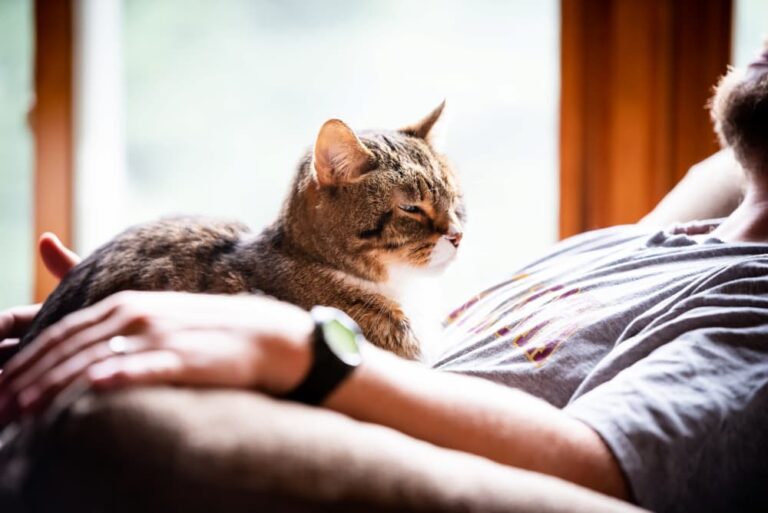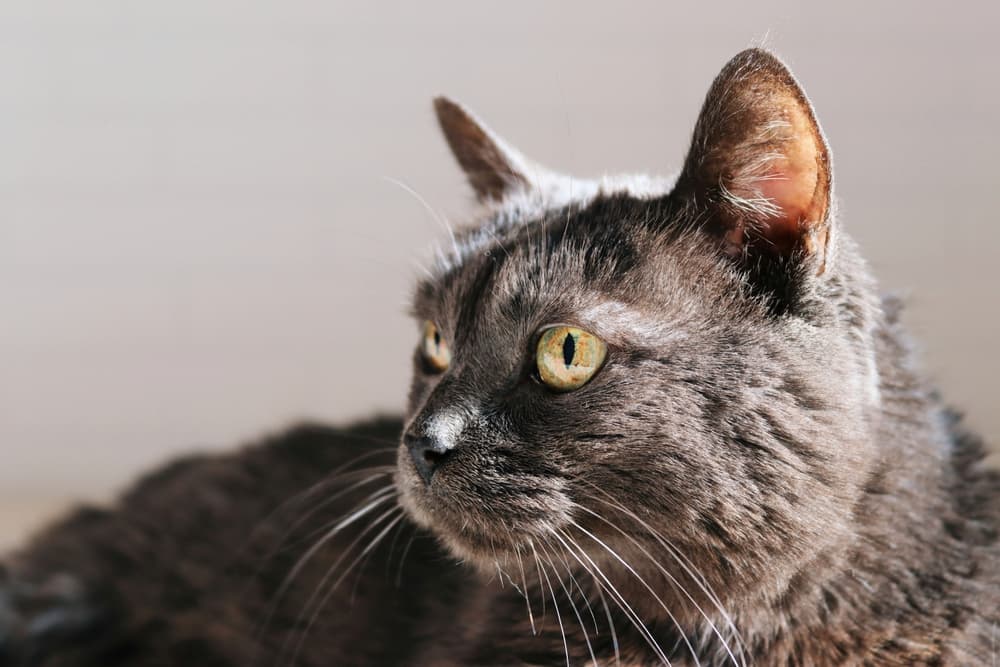Sponsored by CareCredit
A Veterinarian’s Guide to Senior Cat Care

Our idea of when a cat is considered “senior” has changed quite a bit as cat lifespans have gotten longer. It’s not abnormal for veterinarians to see a cat patient in their upper teens or even in their 20s! Typically, we now consider cats to be seniors once they’re over 10 years old (1).
As your cat becomes a senior, you’ll need to make some changes to provide them with the topnotch care they deserve.
Senior Cat Care: What to Expect
As your pet changes with age, the care you’ll need to provide will change with them. Be prepared for:
- Visiting the veterinarian more often
- Regularly checking for lumps and bumps
- Monitoring for signs of pain
- Paying attention to weight gain or weight loss
- Providing low-impact play activities
- Modifying your home to help with mobility
- Changing their diet
- Assisting your pet with grooming
- Increased costs for maintaining your pet’s health
How to Care for a Senior Cat: 10 Things to Know

If your cat is getting older, here is what you need to take into consideration:
Cost
Most senior cats will cost more annually than a younger cat. This is because you’re likely going to see the veterinarian more, going to run more screening tests, may need to treat chronic health conditions, may need to feed more to maintain weight, and may need to make some changes in the home to help your senior pet.
Nobody likes to talk about money, but increased cost of care is an unfortunate reality for senior cat parents.
Make sure to budget for:
- Two annual wellness visits with a veterinarian
- Emergency or urgent veterinary care
- Potential for chronic disease management, such as hyperthyroidism, diabetes, or chronic kidney disease
- Increased food costs, especially if you’ll be feeding a prescription diet
- Grooming appointments if needed
- Home modifications, such as small sets of stairs or elevated food bowls
Some veterinary clinics may have annual wellness plans that allow you to spread costs out over the course of a year, which could make wellness care more affordable for you.
Consider saving at least a couple thousand dollars in an account for your pet so that you can be prepared for unexpected veterinary visits as health concerns arise.
Other options you could consider include pet insurance or the CareCredit credit card. The CareCredit credit card can be used for routine vet appointments, pet surgeries and emergencies, medication, and more, at veterinarian locations that accept the card.*
Regular Vet Checkups
For young adult and mature cats, an annual wellness examination with recommended vaccinations and parasite control is usually sufficient. The veterinarian may occasionally recommend lab work for baseline monitoring.
For our senior cats, we instead recommend twice yearly visits, though senior cats with health conditions may require visits even more frequently.
You can expect the veterinarian to recommend a senior blood panel, an analysis of the urine, and potentially imaging at these check-ups. Vaccinations and parasite control usually follow the same schedule in healthy senior cats as they do in mature adult cats.
Make sure you’re regularly checking for lumps and bumps between wellness appointments. If you’re noticing a growth on your cat that wasn’t there before, it’s best to contact your veterinarian for an appointment.
Common Health Issues
Age isn’t a disease, but it does increase the likelihood of experiencing specific conditions.
A cat of any age can experience health issues, but some conditions are more common in senior cats. Routinely having your pet examined and lab work performed can identify conditions early to improve outcomes.
Conditions we see more frequently in senior animals include:
- Arthritis or degenerative joint disease
- Chronic kidney disease
- Heart disease (such as hypertrophic cardiomyopathy)
- Hyperthyroidism
- Diabetes
- Vision loss
- Hearing loss
- Cancer
- Dental disease
- Hypertension (high blood pressure)
- Cognitive dysfunction (dementia)
Some of these conditions may be managed with medications. Medications your senior cat might take include but are not limited to:
- Methimazole
- Gabapentin
- Polysulfated glycosaminoglycan (Adequan®)
- Frunevetmab (Solensia®)
- Amlodipine
- Diuretics such as furosemide
- Insulin
- Prednisone
A good pet health insurance plan can help offset the cost of vet visits, diagnostic tests, and medications, but it may not cover everything. This is where it can be helpful to consider financing options like the CareCredit credit card.
Behavioral Changes

Some behavioral changes are to be expected in senior cats, such as sleeping more and engaging in play less. However, if your cat has a new or unusual behavior, step one is to get your pet evaluated for medical conditions. Call your veterinarian for an appointment.
Behavioral changes that may indicate an underlying health condition include:
- Changes in frequency of litter box usage (more or less often)
- Peeing or pooping outside of the litter box
- Vocalization, especially at night
- Aimless wandering
- Changes or reductions in jumping and/or climbing
- Changes to appetite or drinking habits
- Poor grooming behaviors
- Increased activity levels and aggression in a previously relaxed cat
Many senior cats will remain playful with the other cats in the home, though some may have a decreased tolerance for youngsters. As far as introducing new cats goes, senior cats may have less patience for new cat siblings, especially playful kittens and young adults.
Nutritional Needs
Senior cats often experience weight loss as they age. These cats require more caloric intake than their mature adult counterparts. This is because they have a reduction in their ability to digest food efficiently and effectively.
Some senior cats will need up to 25 percent more food than they did as a mature adult, though 10 percent to 20 percent is more is typical (1). If your senior cat is obese, you shouldn’t increase their caloric intake and should instead work with your veterinarian on a healthy weight loss plan.
Selecting your senior cat’s diet should be based on their specific nutritional needs rather than ages marketed on food bags or cans. Importantly, there are no guidelines for senior cat diets set forth by the Association of American Feed Control Officials (AAFCO).
The nutritional content of foods labeled for senior cats, especially those that consider senior cats to be 7+ years old, are often not significantly different nutritionally than normal adult cat diets (2).
Some diets labeled for cats 11+ years old do have more calories in a specific amount (higher caloric density), which may be of benefit to older cats who struggle to maintain weight.
Some senior cats, such as those with chronic kidney disease, will do best with a prescription diet designed to help manage their condition.
When in doubt, follow your veterinarian’s recommendations when feeding your senior cat.
Supplements
You should not start supplements for senior cats without speaking with your veterinarian. Common supplements that pet parents consider for their senior cats include:
- Glucosamine and chondroitin (Dasuquin or Cosequin)
- Omega-3 fatty acids
- Cannabidiol (CBD)
- Probiotics
Exercise
When exercising your senior cat, let them dictate the activity level. Some senior cats are still quite playful, and it wouldn’t be fair to restrict their activity just because they’re old.
However, some senior cats, especially those with arthritis or heart disease, may need low-intensity activities.
Examples of low-intensity activities you can do with your senior cat include:
- Spreading interesting but cat-safe scents around the room for them to explore
- Spreading a couple healthy treats around the room for them to find on their own time
- Using a puzzle feeder to keep them mentally stimulated
- Introducing a new or favorite toy
You can continue to use things like wand toys, laser pointers, and cat trees as long as your senior pet remains interested in these objects and is tolerating the activity well.
Signs that you’re overdoing it and need to back down on the intensity of exercise include:
Oral Care

Senior cats are more likely to experience dental disease simply by virtue of having been around the block more. Your veterinarian will check on your pet’s teeth at each wellness exam.
Oral pain can be quite significant for our feline friends, even though they’re quite good at hiding it.
If your veterinarian recommends a dental cleaning or extractions under anesthesia, they’ll also recommend screening your senior pet to ensure they are healthy for anesthesia. Based on screening tests, your veterinarian will design an anesthetic plan individualized for your pet.
Remember, age is not a disease, and many senior cats tolerate anesthesia very well.
Some senior cats have fewer remaining teeth than their younger counterparts, so you may need to change the type of food you’re feeding them. For example, a cat with only four remaining teeth may prefer canned food, although there are many cats who have no teeth that still like kibble.
Grooming
Senior cats may have difficulty keeping up on self-care due to loss of flexibility and the development of arthritis. Senior cats with obesity often have even more trouble reaching hard-to-access locations during their grooming sessions.
Your cat may have some mats here and there that require a little TLC. You should especially watch for mats to develop around the tail base, on the back of the thighs, neck, and armpits. It’s a good idea to ask a groomer or veterinarian to help remove mats, as your senior cat’s thin skin is easy to accidentally nick or cut with a razor or scissors.
Make sure you’re making grooming sessions a positive experience. Be gentle with your senior cat, use soothing tones, and reward them with a nice treat.
Home Modifications
As we get older, we have to modify our homes to suit our own mobility needs. The same goes for our cats. Your cat may have trouble jumping on or off furniture, vaulting cat trees, and navigating the home with vision loss.
You could consider:
- Ramps or small steps leading to their favorite resting areas
- Orthopedic beds that support your cat’s achy joints when they rest
- Smaller cat trees or cat trees with steps or ramps
- Raised food and water bowls for cats who have trouble bending down
- Carpet on the stairs to help with traction
- Traction mats to prevent slipping, such as when they get out of the litter box
- Wide, low-lipped litter boxes on every level of the home
- Using baby gates to restrict access to specific parts of the home
- Placing night lights to help with night vision
For cats with significant vision loss, the most important thing you can do is minimize furniture rearrangement. Blind cats learn to navigate the home by memorizing its layout, and significant changes to that layout can make it hard for them to get around. Consider placing bells on the collars of other animals in the home so that your cat is less likely to be surprised by a rambunctious housemate.
Learning more about your senior cat’s care will help you be prepared as your cat moves into their golden years. While there’s a lot to learn, it sure is nice to know we’re keeping our cats with us for longer than ever before.
References
- Quimby J, Gowland S, Carney HC, DePorter T, Plummer P, Westropp J. 2021 AAHA/AAFP Feline Life Stage Guidelines. Journal of Feline Medicine and Surgery. 2021;23(3):211-233. doi:10.1177/1098612X21993657
- Summers SC, Stockman J, Larsen JA, Sanchez Rodriguez A, Zhang L. Evaluation of nutrient content and caloric density in commercially available foods formulated for senior cats. J Vet Intern Med. 2020;34(5):2029-2035. doi:10.1111/jvim.15858
*Subject to credit approval
This information is shared solely for your convenience. Neither Synchrony nor any of its affiliates, including CareCredit, make any representations or warranties regarding the products described, and no endorsement is implied. You are urged to consult with your individual veterinarian with respect to any professional advice presented.









